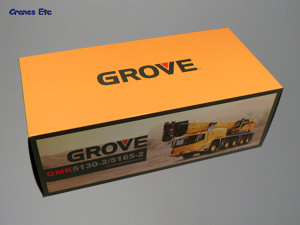 | | The Grove box. |  | 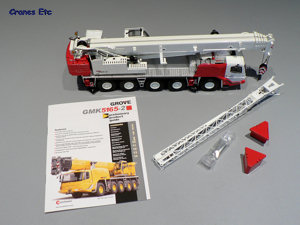 | | The parts out of the box. The main counterweight is already attached when the model is shipped. | 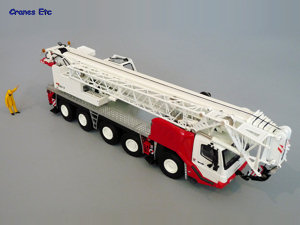 | | Overall view. The mirror on the crane body used by the crane operator is removed for transport. | 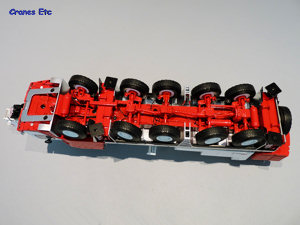 | | Underneath, the model is very detailed. We stress this view is not the result of an accident by the Cranes Etc team. | 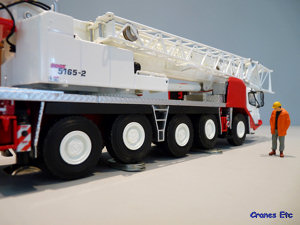 | | The suspension is independent on each wheel, and this allows realistic 'rough terrain' movement. | 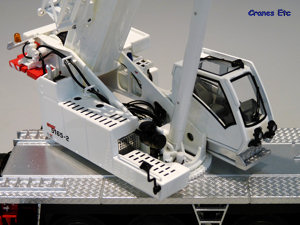 | | Excellent detail around the crane body. The crane wing mirror is fitted in the foreground. | 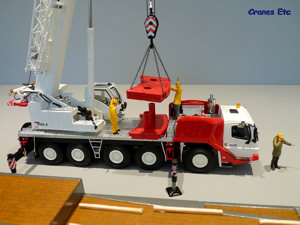 | | Loading up the counterweight. | 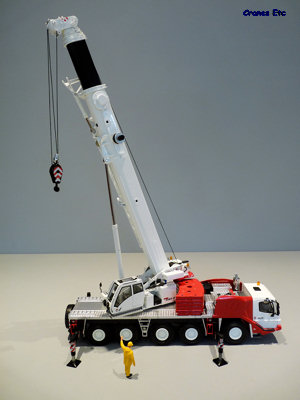 | | Swinging around to attach the counterweight. | 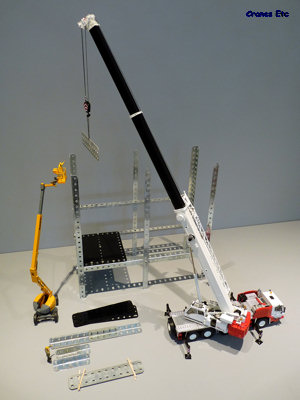 | | Lifting a beam on the main boom. | 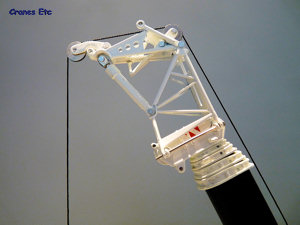 | | Small fly jib in service. | 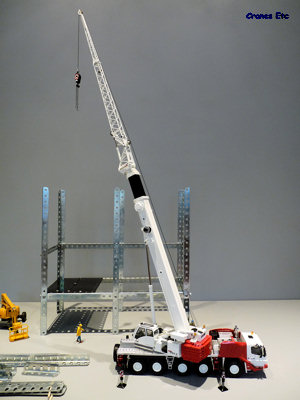 | | The crane with the fly jib set straight. |
| The Grove GMK 5165-2 is a five axle crane rated, as the name suggests, at a 165 US ton capacity. It has a 60m main boom, up to 18m of fly jib and can be fitted with 40 tonnes of counterweight. As a global company, Grove launches their cranes worldwide and they are designated to suit the local markets. In the US this crane is the 5165 whereas in the rest of the world it is the 5130 reflecting the 130 metric tonne rating.
The review model is in red and white, a livery derived from Jeffers, part of the All Crane company of the US.
Packaging
This model comes in a box style which now seems consistent for new Grove models. It has a photo of the crane and some dimensioned line drawings. Inside, the model is well packed in expanded polystyrene trays with some additional soft packing. These protected the review model well and it was undamaged and had no missing parts.
Included with the model is a small version of the Grove product guide which has plenty of information on the real crane. Unfortunately there are no instructions on the model itself and as there are a number of small parts a simple instruction sheet would assist an inexperienced collector. With that said, assembling the parts is not difficult. Out of the box the model is already reeved and all that needs to be fixed are some mirrors and the lattice fly jib.
Detail
The model is satisfyingly heavy when lifted from the box, and it is apparent that it is a detailed crane.
Underneath, the chassis is very detailed with excellent metal transmission and axles, and a full set of replica hoses to each wheel. Engine details are also present. The wheels are the same as on the smaller GMK 3055 model with rough terrain tyres mounted on the same style hubs.
At the front, the driving cab sets a high standard. Inside the detail is very good, with clearly visible instruments and a fire extinguisher. On the outside there are some finely crafted mirrors which have to be fitted, including one unusual long one. There are some very nicely detailed steps into the cab which are complete with a patterned surface. A loop for attaching the hook during transport is provided and an orange beacon light completes the detail on the cab.
The outrigger beams and pads are metal although the beams themselves are single castings and so do not replicate the two stage nature of the real outriggers. In part this modelling decision results in the extension of the outriggers being proportionately significantly less than those on the real the crane. On the plus side the details are great, with warning notices and legs which when extended look like pistons instead of screw threads.
The carrier deck has a strong diamond patterned walkway surface and there are very nice rubber skirts over axles 2-5, with matching rubber mud flaps. Behind the driving cab there is a very fine fuel tank with electric cabling, and a nice exhaust pipe and mesh grating as well as other equipment. At the rear there is a spare tyre, fixed ladders and wheel chocks, and painted light clusters.
Moving to the crane itself, the operator's cab is the same design as fitted to the 2008 revision of the GMK 3055 model and so has the same very good details. There is an excellent array of hydraulic hosing which runs to the slewing motor, winch and counterweight attachment mechanism. Fine mesh grilles and other pieces of equipment give the model a busy and realistic feel. There is a wing mirror to fit on the side of the crane body and another mirror on the top of the crane body that gives visibility of the winch to the operator. Both these mirrors would fold into position on the real crane but are fixed on the model. The Grove name is nicely cast in relief at the rear of the crane and a light bar containing a pair of beacon lights completes the detail.
The counterweight is made up of a series of separate slabs and they each have tabs for lifting chains. The wing weights do not have the same detail so cannot be posed realistically being lifted. The configuration of slabs is an interpretation of those of the real crane, and so posing the model carrying some plates on the deck for transport is a little compromised.
The main lift cylinder for the boom is plastic, but the boom itself is all metal and the lowest section contains detail within the casting and a couple of spooling drums. One of these is wound with thread to represent cabling although sadly it is non functioning. At the boom head there is a block of eight pulleys which is all a single piece so a large multi-line hook would not function properly.
The metal lattice fly jib is very nicely made with fine casting and some excellent pulleys which are thankfully not brass coloured, and may have been even better if they were painted to match the jib.
The hook block is all metal with a three sheave pulley block but again this is a single piece so do not expect freely spooling multi-line operation. The tie off point on the hook appears over large for the scale and is a modelling compromise.
Features
The suspension on the model is very good with each wheel individually sprung which allows realistic poses on rough terrain to be simulated - assuming you like rough terrain in your display case. The steering mechanism links axles 1 and 2, and axles 4 and 5. Axle 3 does not steer, unlike the real crane, so it is not possible to pose crab steering. Also it is not really possible to obtain a hard lock on the steering as tyres start fouling the wheel arches.
The outriggers extend and the pads screw down well and seem robust enough to provide any necessary stability to the model.
On the carrier deck is an opening equipment chest and this and be used for storing small parts such as pins for the model so this is actually quite useful.
The crane cab tilts to an angle of around 30°.
Although not obvious, the counterweight is removable by carefully undoing two screws on the underside and this gives many more display options for the crane including showing a realistic travelling mode, or displaying the crane carrying out self ballasting.
The crane rotates nicely. The boom can be raised easily but this means that the cylinder is not stiff enough to hold much of an angle without drooping so a pin (which is supplied) can be inserted into the cylinder jacket to fix the boom at a high angle. Boom sections telescope and lock smoothly.
The lattice jib can be pinned into place and three combinations are possible; short, medium and long, with each one able to be set at a variable offset angle using the hydraulic cylinder. On the short jib there are two pulleys which fold out to correctly run the line to the hook and this is a very nice feature.
Out of the box the hook comes ready reeved with a three part line. It is possible, but awkward, to convert the hook to a different arrangement by cutting the line and re-tying it but this means threading the line through the tie-off point and re-knotting it. This is however a little frustrating and a slightly amended design of tie-off point would have made this much easier. In reality the model would really benefit from a single line hook to use in conjunction with the fly jib.
Quality
This is another high quality model from TWH with very good detailing. The paintwork and graphics are generally top notch.
Relatively little plastic is used and the overall feel of the model is right.
Price
The model is reasonable value (based on the manufacturer's retail price) for the quality offered.
Overall
This is a very good addition to the Grove stable and the model certainly looks good with the high detail level. There is enough flexibility in the model's design to enable a large variety of poses to be achieved and this will please many collectors.
There are aspects mainly in the area of functionality where there is scope for improvement. It would have been even better if additional lattice jib sections had been provided, and hopefully one day an American crane model will also include a boom dolly like that which is an option on the real GMK 5165.
Footnotes
The model first appeared at dealers in October 2008. The following versions have been produced: yellow 5165-2 version, 300 models: red / white 5165-2 version, 400 models; yellow 5130-2 version, 800 models; Paule version, 250 models; Breuer & Wasel version, 250 models. A smaller capacity version of this crane was released as model TWH 053a in June 2009.
|
| |
| 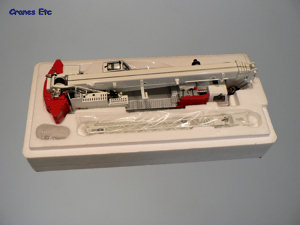 | | The model inside the expanded polystyrene tray. | 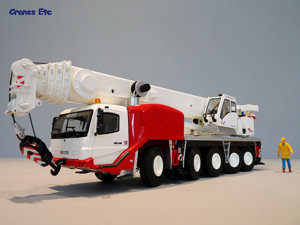 | | The crane in road configuration with counterweight removed. | 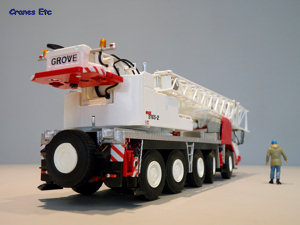 | | Rear view. | 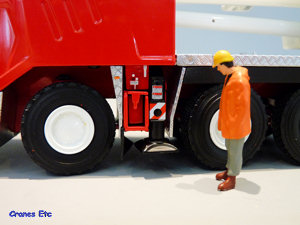 | | Detailed view of the outrigger with warning notice. | 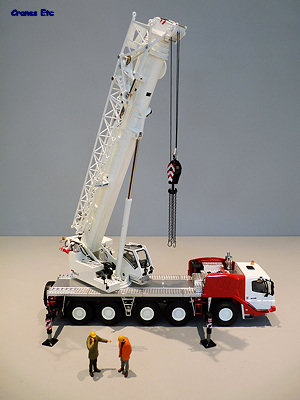 | | Crane waiting for the counterweight to arrive. Here it is fitted with Hooks and Chains. | 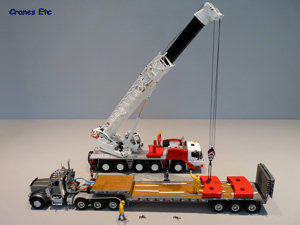 | | A Peterbilt 379 and Nelson Ramp Trailer arrives with the counterweight even though it was a little overloaded. | 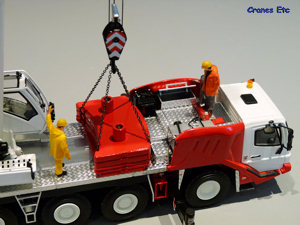 | | There is an opening equipment chest on the carrier deck. Note that the carrier cab has an unusual deep wing mirror fitted. | 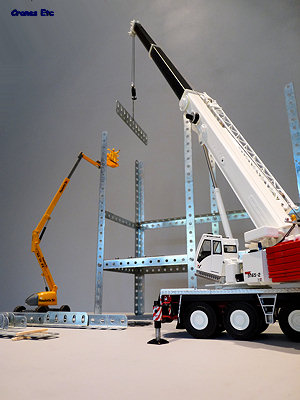 | | Lifting a beam. The crane cab tilts to help the operator avoid a neck ache as he watches the antics of the guy in the Haulotte HA20 PX. | 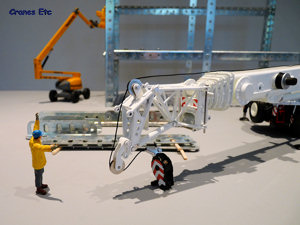 | | Fixing the short offset fly jib. The pulley at the top lifts up into position to provide a smooth route for the rope. | 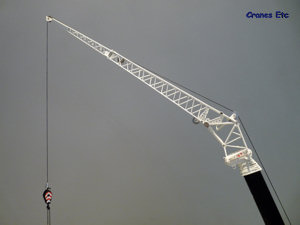 | | The full length fly jib set at an offset angle. | 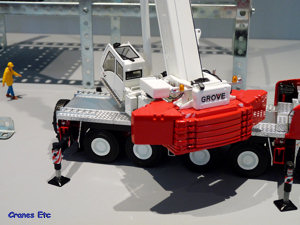 | | Here, the wing counterweights have been added for the heaviest lifting mode. |
|

